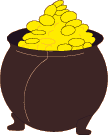Film Activity: "Treasures!"

![]()
Film Activity: "Treasures!"

![]()
Goals:
Work effectively with other students to develop a wide range of ideas that focus on treasures and communicate ideas accurately to the entire class.
Treasure of the Titanic (1992)
Memories of the Titanic
National Geographic: Secrets of the Titanic
multiple juvenile literature sources on treasures of the Titanic (i.e.
myths, stories, poems, etc.)
Kennedy, Richard. (1985). Amy's Eyes. New York: Harper & Row.
Schwartz, Alvin. (1988). Gold & Silver, Silver & Gold: Tales of Hidden Treasures. New York: Farrar, Strauss & Giroux.
Materials:
index cards
markers
large cardboard box (container for the time capsule)
craft items (i.e. beads, glue, sequence, etc.)
duct tape
Time:
Procedure:
2. Each team will develop their own definition of the word treasure and locate a dictionary definition of it. Then they will devise a list of treasures according to the collaboration of the two definitions.
3. Each team will report to the class all of their definitions and lists of treasures.
4. The class will engage in a brief discussion of treasures that is led by the teacher in an effort to enhance their overall knowledge of the subject. Different aspects of the literature content can be brought into this discussion.
5. The teams will regroup and make 8 to 10 creative index cards of treasures they think would have been on the Titanic. These index cards then will be placed in one of the treasure chests.
6. The students will watch a video based on the treasures of the Titanic.
7. The teacher will lead a brief question and answer session to respond to any lingering curiosities of the students.
8. The teams will regroup and adjust their definition of treasure, if needed, after watching the film.
9. Each team will make 8-10 creative index cards of some of the actual treasures that were on the Titanic. These index cards will be placed in the other treasure chest.
10. The students will display the treasures from each chest on a separate wall or bulletin board. The teacher will then lead the students in a comparative discussion.
11. The students will take out the treasures that they brought from home and present them to the class with a brief explanation of why they chose their specific item. These treasures are personal items that the passengers would have brought onto the ship, and they do not have to signify or have any connection to the Titanic. (The students will have been notified to bring treasures from home on the previous day).
12. The class will decorate the large cardboard box with a variety of craft items that will exemplify their concepts of treasures and treasures chests.
13. Each student will place their treasure in the cardboard box, which is their treasure chest (i.e. time capsule), and then the teacher will seal the box with duct tape and place a date on it for when it is to be opened in the future.
14. The students will each have 15-20 minutes to write a short description of their feelings, thoughts, or ideas about treasures in their journals. (Theme ideas: Personal treasures, Titanic treasures, Treasures of the sea, etc.)
Assessment:
Each team must turn in creative index cards with a variety of treasures on them. Criteria for success: Each team must have between 8-10 index cards for each of the activities.
Each team member must actively participate in the various discussions throughout the project. Criteria for success: Each team member must have amble opportunity to speak to the class in at least one or more of the discussions.
Each student must write a creative entry in their journals. Criteria for success: Each student must focus on one of the themes given by the teacher.
Each team must submit an evaluation of the contribution of every member of the team. Criteria for success: Each team member must have made a substantial contribution to the team based on the rubric.
Each team will receive feedback in the following ways:
Curricular Strands and Major Concepts:
Science - exploring the different effects on treasures that are buried in the sea (i.e. coercion, rust, decay, etc.)
Social Studies - comparing different aspects of treasures from the past to the present and, essentially, into the future with the idea of the time capsule, & watching the film on the treasures of the Titanic explores geographical areas
Possible Extensions:
Have the students create a role play that focuses on treasures (i.e. treasure hunts).
Have the students make demonstrations about the different materials of the Titanic's treasures (rusting, corroding, and decaying experiments).
Have the students research the marine life that generally tended to stay near the treasures of the shipwrecks.
Have the students incorporate the sonar technology aspect of salvaging treasures from shipwrecks.
Have the students create story problems focusing on treasures (money exchange, length of time before decay, etc.)
Have the students explore other cultures around the world and compare them to the Titanic's.
Have the students create a map of the area that the treasure is located in for navigational purposes; speaking to a navigational expert on a research ship would be helpful.
The Titanic - developed by Kelly Coleman, Nikki Cosgrove, Megan Mills, &
Dorothy Weber
This page submitted by St. Norbert College Ocean Voyagers Program.